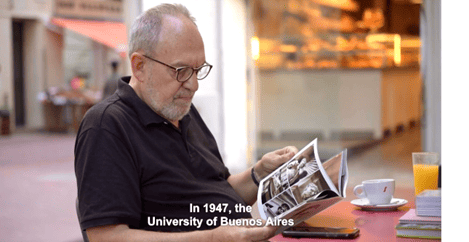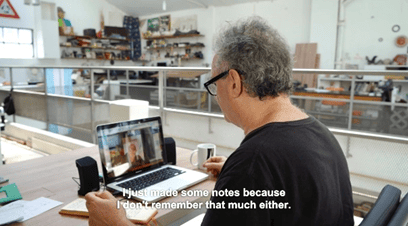“The Ariston, a modern ruin”, its history and its protagonists
«This translation from Spanish (the original text) to English is not professional. I used Google Translate, so there may be linguistic errors that I ask you to overlook. I have often been asked to share my texts in English, which is why I decided to try. I appreciate your patience, and if you see anything that can be improved and would like to let me know, I would be grateful. In the meantime, with all its imperfections, here are the lines I have written». Hugo Kliczkowski Juritz

We were expectant, very expectant, the director Gerardo Panero told us that he could not send us the documentary until it was screened at the 39th Mar del Plata film festival, which began on November 21 and ended on December 1, 2024.

I think he said, “that the festival jury was very strict, and that the documentary should not circulate parallel to the festival.”
I replied:
“…you have me more nervous than my first girlfriend (I don’t know if I was nervous in that century), but it helped me to politely ask her to send it.”
Preview of the documentary «El Ariston» selected in the Official Competition of the 39th Mar del Plata International Film Festival, screenings on November 24 and 25.
We read the comments in the newspapers until we learned that they had given him a special mention.


Friday, November 29, 2024
“El Ariston”: documentary covers the history of the parador and can be seen at the Film Festival.
It is the famous parador located on the southern beaches of Mar del Plata.
The documentary film is directed by Gerardo Panero. In 2013 he directed the film about Amancio Willliams, the architect of the House on the Stream.
Argentine Feature Film Competition
-First Special Mention “EL ARISTON” by Gerardo Panero.
-Second Special Mention to Lautaru Bettoni and Benicio Mutti Spinetta for their performance in “NO CORRE VENTO”.



Gerardo Panero has a degree in Audiovisual Arts Teaching (UNSAM) and a graduate of ENERC (National School of Film Experimentation and Production).
-He worked as a sound director in fiction feature films, documentaries, TV series and advertising.
“Chivilcoy, the foundation of a past”
It won the 2010 digital TV award, shown by Canal Encuentro and Argentine Public TV.
“Amancio Williams”, documentary feature film.
Nominated by the Academy of Cinematographic Arts and Sciences of Argentina for the “Sur” 2014 award and nominated for the Silver Condor by the Association of Cinematographic Chroniclers of Argentina in 2015
“Plan for Buenos Aires”
It received the award for best documentary at the Guatemala International Film Festival.


Year 2024
Duration 67 min.
Country Argentina
Address Gerardo Panero
Screenplay Gerardo Panero
Lito Vitale music
Photography Daniel Hermo
Companies Fueye Films
Documentary Genre







Nov 24, 2024
Gerardo Panero

The Ariston The director brings us what the famous tourist inn is and what it was. Interview: Javier Erlij, Edition: Alejandro Ramirez.
https://www.ivoox.com/documental-sobre-ariston-festival-de-audios-mp3_rf_136220405_1.html

The Ariston, located in Playa Serena, is the work of architect Marcel Breuer.
“El Ariston” is the documentary that traces the history of the famous parador located in Playa Serena, in the southern area of Mar del Plata. Directed by Gerardo Panero, the film will be part of the programming of the Mar del Plata International Film Festival, which will begin this Thursday in various theaters.

It was exhibited in three performances, within the Argentine Competition section: this Saturday at 10:10 and 7:20 p.m. and this Sunday at 4:10 p.m. in room 4 of Paseo Aldrey.
Panero, an Argentine film director born in the city of Chivilicoy, came to Ariston from a previous documentary work – made in 2013 – that revolved around the figure of Amancio Williams, architect of the famous “House on the Brook” , also located in Mar del Plata.

“The first approach was through the figure of Amancio, I investigated the deployment of the architecture of Mar del Plata and how the references of modern architecture did work in this city. This is how he came to know the history of the now abandoned inn and its architect Marcel Breuer».

Breuer is a key figure in the Bauhaus, a movement founded in Germany that renewed art and architecture.

In 1947 he visited Argentina and designed the Parador Ariston under the avant-garde criteria of said school. 1947 is a time of much development in architecture, a time of social changes, he said in an interview with LA CAPITAL.

It was built to be able to carry out urban development in that area (south of Mar del Plata). The idea was to sell the land, because with the creation of the Chapadmalal complex and Route 11 it was thought that these neighborhoods could be urbanized. And the parador was the first place of interest to populate that area.”

The documentary tells the architectural history of Mar del Plata and how with the passage of time the Ariston was forgotten and its slow destruction began.
This story leads us to reflect on the importance of architectural heritage in a city.turística.

For the filmmaker, the possibility of screening this film for the first time in Mar del Plata represents, in addition to “immense joy,” a “natural” screen for its premiere, given the closeness to the story and the people who participate in the film. .
In that sense, Mar del Plata historians contribute their voice to the documentary, as happens with Elisa Pastoriza, among others.
Synopsis

In 1947, Marcel Breuer, a fundamental figure of the Bauhaus, visited Argentina and designed the Parador Ariston in Mar del Plata. As time goes by, the Ariston will fall into oblivion.
The context in which it was created leads us to discover how Mar del Plata is transformed into the dream city for Argentine families’ vacations and the importance of architectural heritage.
Reviews

«It is one of those neat and well-put together films that meets the objectives it sets out to do: take something that is visible to everyone and, from that, see what its story tells us about the present. «It won’t be much, but it won’t be little either.» Score: ★★★ (out of 5)». Ezequiel Boetti, OtherCines.com
Documentary about Ariston at the Mar del Plata Film Festival, November 22, 2024.
Review of “El Ariston”, documentary by Gerardo Panero (Argentine Competition). By Ezequiel Boetti. OtherCines.com

The hidden story behind an architectural jewel abandoned to its fate very close to Mar del Plata.
The Ariston (Argentina/2024). Direction and script: Gerardo Panero.

With the testimonies of Horacio Goyeneche, Hugo Kliczkowski Juritz, Magali Marazzo, Gustavo Nielsen, Elisa Pastoriza, Moira Sanjurjo and María Talay. Photography: Daniel Hermo. Edition: Emiliano Fardaus. Art direction: Laura M. Faccinelli. Sound: Gino Gelsi. Music: Lito Vitale. Producers: Gerardo Panero, Franco Carbone, Eliana Ponzano. Production house: Fueye Films. Duration: 67 minutes.
Like any abandoned construction, the Parador Ariston is the trace of a truncated promise, of a past that predicted prosperity and joy for a future that, of course, never came. And the one that today is eaten away by the Atlantic saltpeter and surrounded by grass is also the only work in Latin America that bears the signature of the Hungarian architect Marcel Breuer, one of the great references of the modernist movement of the mid-20th century.

That parador, located a few kilometers south of the center of the city of Mar del Plata, is the end of the ball that the director Gerardo Panero pulls to investigate the way in which architecture becomes a fragment of urban identity, at the same time as a very faithful representation of the winds that blew in each era. This explains why Mar del Plata is characterized by what one of the several specialists who speaks to the camera defines as a “construction-destruction-construction” cycle.

There are the photos and testimonies that remind us of the imposing French promenade in the Belle Époque style that was built at the beginning of the last century and that was demolished just 20 years later.

They also remember that the new design, which remains in place to this day, responds to a new working class that was beginning to take over a place that until then had belonged to the elites.
This parador, thought to be a reference for the then incipient urbanization of the beaches near the lighthouse, dates back to that time, an advance that would be crowned with the creation of Chapadmalal on land expropriated from the Martínez de Hoz family.
Appealing to the most recurrent uses and customs of expository documentaries, with their mix of talking heads and archival material spun by a voice-over.


Review of “El Ariston”: Memory and abandonment of a Bauhaus icon
By Juan Pablo Russo. Friday, December 6, 2024
The narrative is nourished by exhaustive research and achieves a balance between historical analysis and an aesthetic sensitivity that invites us to rethink the relationship between memory and space. The progressive destruction of the Parador Ariston highlights the challenges faced by heritage conservation in a city whose identity is strongly linked to tourism.
The Ariston is more than a testament to Marcel Breuer’s legacy; It is a reminder of how carelessness can blur the value of works that defined an era. In this sense, the documentary becomes a key tool to raise awareness about the need to value and protect these structures.
Publication in the New York times on April 21, 2019
Reporters Alex Marshall and Miriam Quick
The New York Times made a special supplement on the occasion of the 100 years of the Bauhaus, they asked me for collaboration and I asked them in return to give a special place to the Parador Ariston, which they did by putting it on the cover of Arts&Leisure, and pages 14 and 15.




Previous postMagna Graecia. The Doric order
2 comments on “The documentary «El Ariston» is awarded at the 39th Mar del Plata Film Festival”
Gustavo NielsenEditar Qué informazo, gracias!!!
What a great information, thank you!!!
hugoklicoDecember 5, 2024 at 3:44 pm.The architect deserves the
———————————————–
Our Blog has obtained more than 1,300,000 readings: http://onlybook.es/blog/nuestro-blog-ha-superado-el-millon-de-lecturas/

Arq. Hugo Alberto Kliczkowski Juritz
Onlybook.es/blog
Hugoklico.blogspot.com
Salvemos al Parador Ariston de su ruina
http://onlybook.es/blog/el-parador-ariston-una-ruina-moderna-por-hugo-a-kliczkowski/